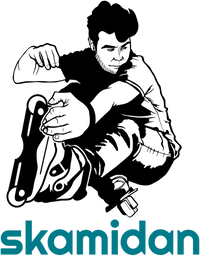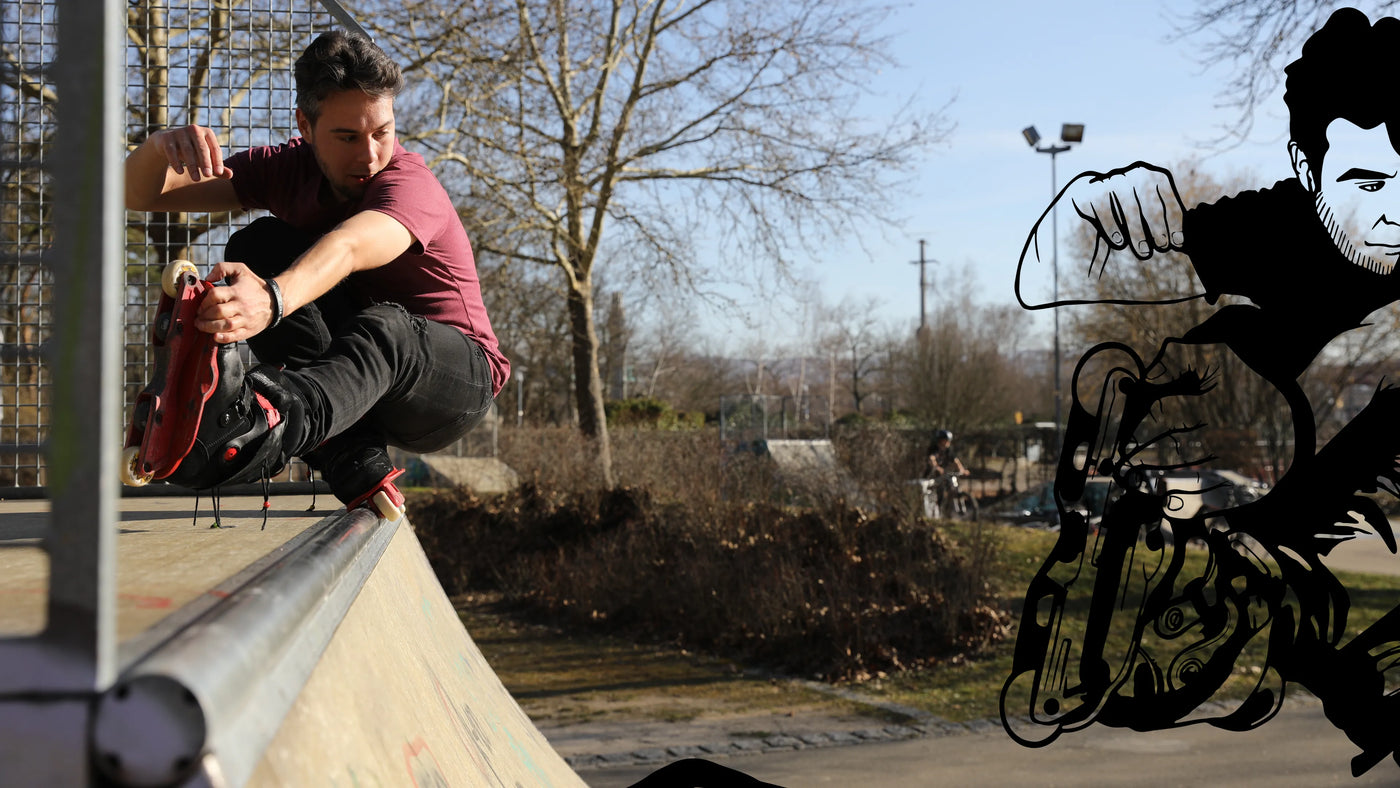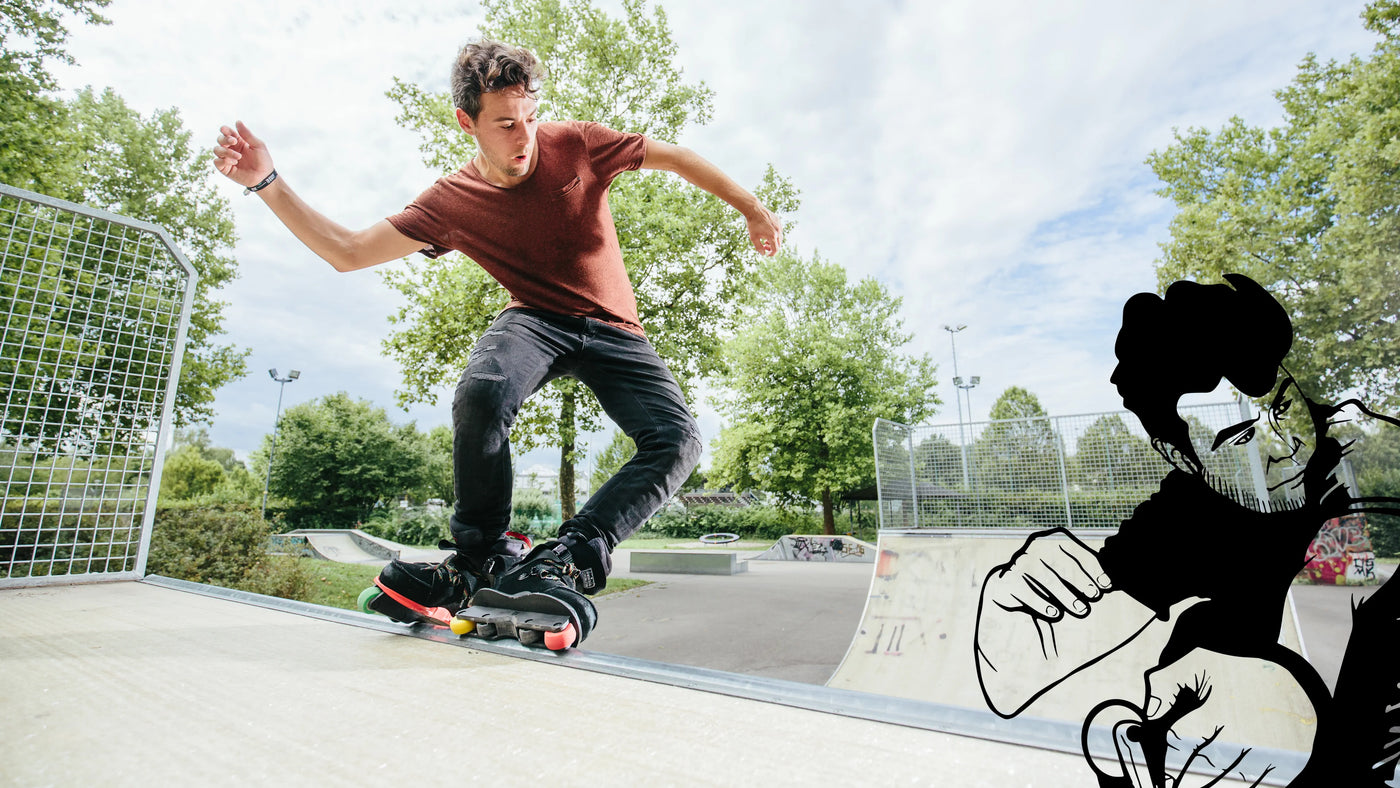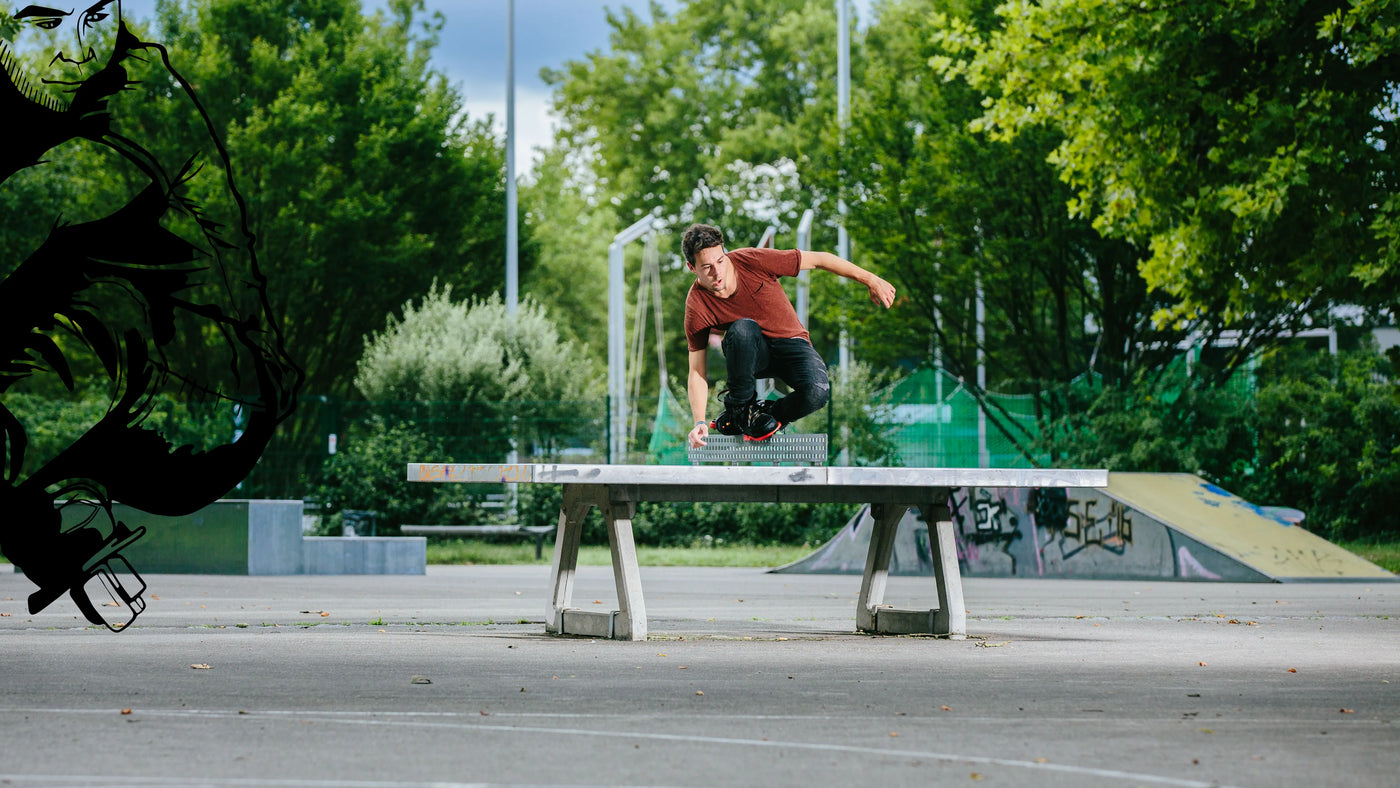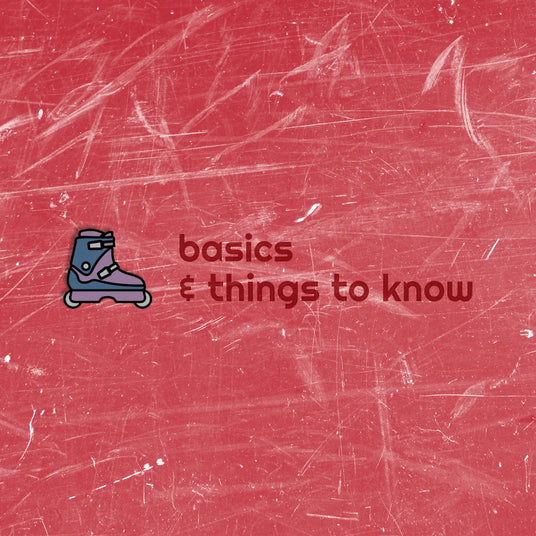
What is Aggressive Inline Skating?
The action-packed world of Aggressive Inline Skating
Aggressive Inline Skating is the most action-packed and technically demanding discipline in inline skating.
It’s not about speed or covering long distances, but rather about performing spectacular tricks, jumps, grinds, and slides – gliding along edges, rails, or ramps.
This sport combines creativity, athleticism, and urban lifestyle, and is mainly practiced in skateparks, halfpipes, or in so-called “street” settings (on urban obstacles like stair rails, walls, or curbs).
Aggressive Inline Skating, in this blog, you’ll find everything you need to know about this action-packed extreme sport on wheels.
What is Aggressive Inline Skating – Everything you need to know
The action-packed world of Aggressive Inline Skating
Using the following table of contents, you can easily navigate through this blog and jump straight to the topics that interest you:
- Action Video
A first glimpse into the world of Aggressive Inline Skating.
Watch - What is Aggressive Inline Skating and how can you best learn it?
Tricks, mindset, fun, and loads of action.
Watch - The most important disciplines within Aggressive Inline Skating
Styles and specializations
Watch - What rules exist in Aggressive Inline Skating?
Legal and unwritten Rules
Watch - The history of Aggressive Inline Skating
From DIY tricks to DIY skates to a global scene
Watch
A first glimpse into the world of Aggressive Inline Skating
First Stop – Action Video
Aggressive Inline Skating is trick skating in skateparks or at so-called street spots – places like walls, stair rails, or curbs.
This discipline is also known as rollerblading or, more colloquially, stunt skating.
To get a first impression of the world of Aggressive Inline Skating, feel free to watch our video:
In it, we follow our team riders Jakob and Macl as they tear up a skatepark in Belgium – with loads of tricks, style, and above all, fun!
Tricks, mindset, fun, and loads of action
What is Aggressive Inline Skating and how do you learn it best?
Aggressive Inline Skating is far more than just a variation of inline skating, it’s a powerful, creative, and expressive extreme sport that focuses on spectacular tricks, grinds, and jumps. Whether on ramps in the skatepark or out on the streets at stair rails and curbs: Aggressive skating demands courage, technique, body control, and a strong mindset.
Whether you’re skating a quarterpipe at the park or hitting a DIY spot on the street. Aggressive Skating thrives on the creativity of the scene and the willingness to push boundaries, both athletically and personally. For many, it’s more than just a sport. It’s a way of life.
The skates used for this discipline are significantly different from regular inline skates. They’re built especially tough, with reinforced shells, smaller and harder wheels, and special grind frames that make sliding across rails or edges possible. The so-called soulplate, a widened surface on the side of the boot, also allows for tricks that would be impossible otherwise. This way, every curb or handrail becomes a playground for new ideas.
Getting Started – Tips, Tricks, and Learning the Basics
Getting into Aggressive Skating and the scene is easier today than ever before. Many skateparks offer ideal conditions to learn how to skate ramps in a safe environment and try out your first tricks.
Especially as a beginner, we recommend taking the time to learn the fundamentals:
- Balance
- Riding up and down ramps
- Training your jumping power
- Learning your first basic grinds
- And anything else that builds your confidence
The best part: we support you at every step with a variety of free tutorials and our dedicated beginner’s guide.
We also strongly recommend wearing proper protective gear – not just for safety, but because it also boosts your confidence, strengthens your mindset, and helps you stay calm and focused while trying new things.
For Aggressive Inline Skating, we recommend the following protective gear:
- A stunt helmet
- Wrist, knee, and elbow pads
- Shin guards (especially important when learning grinds)
- Padded shorts (crash pants) with tailbone protection
You can find more details about protective gear and all other equipment recommended for Aggressive Inline Skating here.
What Makes Aggressive Inline Skating So Special and Rewarding
What sets Aggressive Inline Skating apart is the combination of physical challenge and mental strength. Setbacks are part of the journey, especially at the beginning. But every trick you work for, every line you land cleanly, gives you a feeling of freedom, pride, and real flow. Over time, you’ll not only develop skating skills but also endurance, patience, and creativity, qualities that reach far beyond the sport itself.
What’s more: the community is open, supportive, and tightly connected. Once you’re part of the scene, you’ll quickly see how inspiring it is to share with other skaters – at the park, in the city, or online. Shared sessions, motivating each other, and celebrating progress together are a huge part of what makes this sport so appealing.
Aggressive Inline Skating is for anyone who craves movement, adrenaline, and urban style, no matter your age or athletic background. It’s not about grinding like a pro right away – it’s about exploring your potential and having fun. Every trick counts. Every step forward is a personal victory.
So: if you’ve ever thought about getting more out of your skates – now is the perfect time. Strap on your skates, find a spot, and discover what you’re capable of.
With the gear from our shop, our tutorials, trick lists, and in-person courses, we offer the complete package to get you rolling!
And lastly, we’ve also put together an A-to-Z glossary of all the key terms in Aggressive Inline Skating to help you get familiar with the sport’s unique lingo.
Styles and Specializations in Aggressive Inline Skating
The Most Important Disciplines within Aggressive Inline Skating
Aggressive Skating is an extremely versatile sport practiced across various disciplines, depending on the environment, personal style, and trick preferences. Each of these disciplines comes with its own set of challenges, technical demands, and creative possibilities.
Here’s an overview of the four most important styles, along with practical examples, typical locations, and helpful insights for getting started.
1. Street Skating – Urban Lifestyle on Wheels
Street skating is the original and most creative form of Aggressive Inline Skating. Skaters turn urban landscapes into their own personal playgrounds: anything with an edge, stairs, curves, rails, or angles becomes a potential trick spot.
Typical street obstacles (street spots):
- Handrails – perfect for grinds like Topsoul, Royale, or Backslide
- Ledges – great for slide combos like Unity, Acid, or Makio
- Gaps & stairs – ideal for jumps, 180s, 360s, or stylish drops
- Curbs – excellent for beginner tricks and technical practice
Key features:
- Creativity and improvisation are essential
- Every spot is unique – no repetition like in a skatepark
- Often requires spot-scouting and grind wax to smooth out edges
Street skating is especially popular in the so-called core scene, thanks to its emphasis on individual style and a strong DIY spirit.
2. Park Skating – Technical Riding in the Skatepark
Park skating takes place in dedicated skateparks designed specifically for tricks and stunts. These offer a wide variety of ramps and obstacles that allow you to create stylish lines and precise trick combinations.
Typical skatepark elements:
- Quarterpipes – for launches, flips, or transition tricks
- Funboxes – combined elements with ramps, rails, and gaps
- Curbs – perfect for learning slides and grinds
- Pyramids & spines – for transitions and air-to-air tricks
- Rails – angled rails for beginners and advanced riders
- Jumpboxes – for big jumps and lots of airtime
Advantages in the park:
- Safer thanks to flat surfaces and clearly defined obstacles
- Planned lines make targeted trick training easier
- Many parks are now lit and partially covered
Park skating is very beginner-friendly and a great place to fine-tune your technique, hang out with friends, and connect with the community.
3. Mini-Ramp & Bowl Skating – Endless Flow & Style
his discipline blends elements from both street and park skating but focuses on fluid motion, transitions, and stylish lines – perfect for those chasing the “flow” feeling in skating.
Mini-Ramps:
- Low halfpipes with walls about 1–1.5 meters high
- Ideal for learning airs, coping grinds, 180s, and reverts
Bowls:
- Bowl-shaped structures with continuous curves
- Like empty pools – perfect for endless motion
- Often feature sections of different depths for all levels
Typical tricks:
- Transfer grinds – between ramp segments
- Switch-up grinds – changing tricks mid-grind
- Stalls on the coping
- Airs with grabs
- Spins and flips in mid-air
- Lip tricks on the coping
Mini-ramp and bowl skating develop your rhythm, timing, and transition skills and look incredibly stylish while doing it.
4. Vert Skating – The King Discipline in the Halfpipe
Vert skating is the most spectacular discipline, performed on massive vert ramps with vertical walls (often over 3 meters high). Skaters launch out of the ramp to perform complex airs, spins, and grinds on the coping.
Typical tricks:
- Airs – high jumps with stylish grabs and poses
- 540°, 720°, 900° spins – for advanced and pro skaters
- Flips & misty flips – backflips and off-axis rotations
- Grabs – like mute grabs or rocket airs
Defining traits:
- Extremely demanding in terms of aerial balance, technique, and endurance
- Requires maximum body control
Vert ramps are rarer but a highlight at contests and select skateparks.
Vert skating was once the centerpiece of the X-Games and still gives goosebumps to spectators today.
Each Discipline Has Its Own Charm
Whether you prefer grinding urban rails, flowing through stylish park lines, or soaring through the air in a halfpipe. Aggressive Skating offers something for everyone.
The variety of disciplines keeps things fresh and allows you to continuously grow. The mix of technique, adrenaline, creative expression, and strong community spirit makes this sport truly unique.
Legal and unwritten rules
What rules exist in Aggressive Inline Skating?
Legal Framework
In Germany (and many other countries), inline skaters are legally not considered pedestrians. Instead, they fall under the category of “special means of transport” – similar to scooters or skateboards.
In general, the following applies:
- Sidewalks & pedestrian zones: skating is allowed as long as others aren’t obstructed or endangered.
- Streets and bike lanes: only permitted when no safer alternatives exist and no risk is posed.
- Skateparks, public areas, or sports facilities: may be used if there are no prohibition signs.
What is prohibited:
- Skating in train stations, shopping centers, parking garages, or on private property without permission
- Skating at historic sites, religious buildings, or public monuments
- Endangering others, such as by skating quickly through crowds
Tip: Many cities now offer official street or parkour areas where aggressive skaters are welcome. Ask your local city office or skate shop for info. When skating street spots like rails, ledges, or walls, you're often in a legal grey zone.
Is it legal or illegal?
- Grey zone: Most public spots are accessible, but not officially skate-approved.
- Private property (e.g. office buildings, schools, malls) may only be used with permission.
- Trespassing (§123 StGB) applies if you enter a location despite posted warnings.
It’s not automatically illegal – but if you ignore rules, damage property, or act disrespectfully, you might face a warning, fine, or legal trouble.
The Unwritten Rules of the Scene – Skate Etiquette
Anyone in the aggressive skating scene knows: there are unspoken codes of conduct that earn you respect and acceptance.
- “Don’t be a spot killer!”
When skating street spots: Leave no trash, no damage, and keep noise down; No vandalism – your behavior represents the entire scene. - Skatepark Etiquette
Drop-in rules: Skaters take turns based on waiting order, not skill level. Whoever’s been waiting longest goes next.
Don’t block lines: Always look around before you drop in so you don’t cross someone’s line or cause a crash.
Respect newcomers: Everyone starts somewhere. Offer help, not hate – supporting new skaters helps the scene grow. - Filming & Photography
Ask first before filming or taking pictures of other skaters.
When filming at spots: avoid showing license plates, sensitive buildings, or bystanders. Blur anything private before publishing. - Respect the Locals
If you’re new to a city or spot: Don’t cut in, take over, or show off; Many locals have discovered, maintained, or even built the spot
Legal Protection & Insurance – Often Overlooked
For serious skaters, it’s worth considering:
- A private accident insurance, especially for street skating and contests
- A personal liability insurance to cover accidental damage to others or their property
Skate with Respect – Legally & Fairly
Aggressive Inline Skating thrives on creativity and freedom – but those end where others are disturbed or endangered.
By skating with awareness of laws, respect for the community, and good etiquette, you’ll not only avoid issues but also gain more fun, safety, and recognition.
Aggressive Inline Skating: From DIY Trick to DIY Skate to a Global Scene
The History of Aggressive Inline Skating
Aggressive Inline Skating has a fascinating and multi-layered origin story, deeply tied to urban youth culture, a spirit of innovation, and a certain degree of rebellion. From improvised DIY solutions to professional contests like the X-Games, it has been a journey full of creativity, development, and at times, resistance to the mainstream.
Here you’ll find a thoroughly researched overview of the origins, milestones, and pioneers of this unique rolling subculture.
1. The Invention of Inline Skates – Technical Origins
Before “Aggressive Skating” could exist, the first inline skates had to be invented and developed for the market. The idea of mounting wheels in a line under a shoe dates back to the 18th century. But it wasn’t until the late 1970s that this idea met modern materials and concepts.
Key developments:
1980: The brand Rollerblade is founded by brothers Scott and Brennan Olson. They discovered old inline constructions and improved them with polyurethane wheels, ski-style hard boots, and modern brakes.
1980–1983: Rollerblade releases the first mass-market inline skates, mainly for fitness and endurance training and particularly as a summer alternative for ice hockey players.
🡒 Important: At this time, there was no focus on tricks, but the skates were already stable enough for experimenting with jumps and slides. Hockey players and surfers soon started trying out their first tricks on inline skates – laying the groundwork for a new skate culture.
2. Early Experiments & First Trick Attempts (ca. 1985–1989)
In the mid-80s, a few athletes – primarily in California – began jumping, sliding, and improvising on their inline skates. Their inspiration came from skateboarding and BMX.
Who was involved?
- Chris Edwards (later known as the “Godfather of Aggressive Skating”) recalled his first grinds in the late 80s – on curbs, walls, or improvised rails.
- Other skaters from hockey or roller hockey backgrounds also began experimenting on sloped driveways, park benches, or small ramps.
- Some crossover came from the snowboarding and surf communities, where board sports enthusiasts were seeking urban alternatives.
🡒 During this time, the first street-inspired skate sessions emerged, where the urban environment was deliberately used as a skate spot – even though there was no established community or scene structure yet.
3. The First DIY Modifications to Inline Skates (1988–1990)
Since there were no dedicated trick skates, early skaters began modifying their fitness or hockey inline skates to make them trick-ready.
Although the term “Aggressive Skating” didn’t exist yet, the DNA of the sport was already present: urban style, improvisation, courage, and DIY solutions. This decade was marked by experimentation, laying the groundwork for professional skates, brands, and competitions.
Typical modifications included:
- Removing the middle wheels to improve H-blocks (which later led to the anti-rocker setup). The H-block refers to the middle part of the skate frame used for grinding (back then, just the area without wheels).
- Cutting notches or grooves into the frame to expand the H-block for more rail space
- Gluing plastic plates to the sides of the boots; some even used metal plates screwed in – early soulplates, often just a few millimeters wide
- Reinforcing boots with duct tape or resin
- Shortening or removing the brakes altogether
These modifications were not only functional but also expressions of creativity – a genuine DIY culture developed, comparable to the early days of skateboarding.
One of the first commercially available aggressive inline skates was the Rollerblade Lightning TRS (Team Rollerblade Series), released in the early 90s and optimized for tricks. Chris Edwards was a key team rider in its development.
4. Media, Music & Inspiration from Subcultures
Parallel to the technical evolution, the cultural scene acted as a catalyst:
- Hip-hop, punk & hardcore dominated 80s youth culture
- Breakdance, graffiti, BMX, and skateboarding were expressions of urban lifestyle
- Skate videos like Bones Brigade (skateboarding) inspired young athletes to try similar moves on inline skates
🡒 Aggressive Inline Skating didn’t originate in fitness studios – it came from the streets, from subcultures that defied conventional sports rules and celebrated raw creativity.
5. The Rise of the First Brands (1990–1995)
Between 1992 and 1995, the first companies recognized the potential of this new trend. Brands emerged that were fully or primarily dedicated to aggressive inline skating:
Key early brands – many of which are still central today:
- Rollerblade – pioneer of aggressive models with the TRS Series (1988)
- Roces – launched the legendary Roces M12 (still in production today, 1996)
- K2 – released their first aggressive skate, the Fatty, a softboot model (1996)
- USD (then "Upside Down"), founded in 1997 by Matthias Knoll and his company Powerslide; renamed Universal Skate Design in 1998, focused on street skating
- Salomon – revolutionized setups with the ST-8 and later the iconic STi
- Razors – known as a pure aggressive brand from the mid-90s, released the Razors Cult in 1998
- Remz – first released their aggressive inline skate in 1998, designed by Kato Mateu. It lacked an official model name – simply known as the Remz Aggressive Skate
6. The Golden Era: Competitions, Media & Stars (1995–2005)
This was the height of aggressive inline skating. The discipline became part of the X-Games (1995–2005), with global magazines, videos, and professional sponsorship deals.
Famous skaters of this era:
- Chris Edwards – pioneer & legend
- Aaron Feinberg – known for his fluid style
- Brian Aragon – technically flawless grinds
- Franky Morales – style icon
- Jon Julio – scene leader & founder of THEM Skates
Iconic videos & milestones:
- Hoax Series (1994–1999) – genre-defining
- Brain Fear Gone (2000) – landmark in skate film history
- VG (VideoGroove) – cult-status video magazine
7. Decline & Niche Phase (2005–2015)
After the X-Games dropped the discipline and media coverage declined, aggressive skating became more underground. Many large companies withdrew.
The scene survived through:
- DIY commitment
- Self-organized contests
- YouTube & forums
Important grassroots projects emerged, such as:
- Blading Cup (founded by Jon Julio)
- Winterclash – Europe’s largest indoor aggressive skating event (founded by Johannes Jacobi)
8. Revival & New Brands (2015–Today): The Return of Aggressive Inline Skating
How did the revival happen? – The key factors:
8.1 Social Media & New Platforms
Around 2014–2015, platforms like Instagram, YouTube, and later TikTok became crucial. Skaters could share tricks, edits, and vibes with the world – without needing traditional media or sponsors:
- Hashtags like #blading, #aggressiveinline, #bladeculture boosted visibility
- Accounts like @bladergang, @them_skates, @rocesofficial, @mushroomblading became digital hubs
- New generations discovered the scene via algorithm – often without prior exposure
8.2 Jon Julio, the Founding of THEM Skates (2018) & USD by Powerslide
A key turning point was the launch of THEM Skates by Jon Julio, a scene legend and former pro for USD and Valo.
Why THEM was important:
- Independent company – by skaters, for skaters
- High community focus, no corporate backing
- Clean, style-focused, minimalist design – aligned with the times
- Actively supported young skaters, filmmakers, and DIY projects
- THEM became a symbol of the scene’s renewed self-confidence – more than a product, a movement, akin to Supreme in streetwear.
Why USD was important:
USD played a vital role in developing, preserving, and evolving the scene:
- Pioneered modular designs, carbon skates, and UFS frame system
- Consistently supported pros and newcomers alike
- Sponsored iconic contests and media projects like Coup de Tat, Hoax, and digital film series
- Maintained innovation, loyalty to the scene, and continuity despite shrinking markets
8.3 Return of Classic Models – Nostalgia as a Catalyst
Many skaters from the 90s and 2000s returned – often now as parents, introducing their kids to the sport.
Rediscoveries included:
- Old skates from the attic
- Re-releases like the Roces M12, USD Classic Throne, Razors Cult
- New shops (like SkaMiDan) and modernized communities
- Classic skates with improved materials and modern aesthetics bridged old and new generations.
8.4 New Brands & High-End Products
Beyond THEM Skates, several new or reinvented brands emerged with stylish, high-performance, and specialized products.
Examples:
- Adapt Brand (NL) – high-end, handmade carbon skates
- Iqon – young, urban, modular
- Gawds Skates – Franky Morales’ brand with a streetwear vibe
- USD – brought back classics and created the Sway model
- Playlife (USD’s entry-level line) – affordable aggressive skates for all income levels
- Roces – successful comeback with M12 and Fifth Element
- Razors – returned with updated models
- Mesmer Skates – new brand under Bladergang, street-focused
8.5 DIY & Independent Culture as the Scene’s Backbone
Post-2015, the industry didn’t revive the sport – the community did. Fueled by passion, not marketing budgets, projects included:
- Crowdfunded skate releases (e.g., first THEM series)
- Professionally edited DIY skate videos
- DIY skateparks & urban spots
- Community-driven events like Blading Cup, Winterclash, Rumble in Rotterdam
8.6 Media Relevance & Modern Aesthetics
Aggressive skating became more aesthetic, calm, and mature – but no less technical. Many new edits feature:
- Analog looks (Super 8, 90s filters)
- Streetwear integration
- Storytelling, not just trick montages
- Artistic angles, music integration, urban photography
This helped attract new audiences outside the traditional aggressive skate scene.
8.7 Return to Public Visibility
Thanks to these developments, aggressive skating reappeared:
- Visibly present in skateparks (alongside BMX & scooters)
- Integrated into fashion and art projects
- Featured again in action sports media
- Global events like Winterclash now host skaters from over 50 countries
- New local communities are rising – especially in Eastern Europe, South America & Asia
The Revival is Real – And It’s Not Over
The revival of aggressive inline skating isn’t just a trend – it’s a lasting movement, powered by skaters, designers, creatives, and fans. Today’s scene is:
- Smaller, but more passionate than ever
- Style-conscious, community-driven, and tech-forward
- Open to newcomers and proud of its culture
Final Word: The Story Lives – And Rolls On
Aggressive Inline Skating has seen an impressive evolution – from improvised grinds in the 80s to a global boom in the 90s, and now a creative comeback in recent years. What once arose from passion, courage, and urban freedom is now more than ever a symbol of style, individuality, and community.
The story isn’t over – it’s still being written.
And maybe today is the day you start rolling your own chapter.
Winterclash 2025 Official Aftermovie
Dive into the world of the Aggressive Inline Skating community and Europe’s biggest skate contest.
